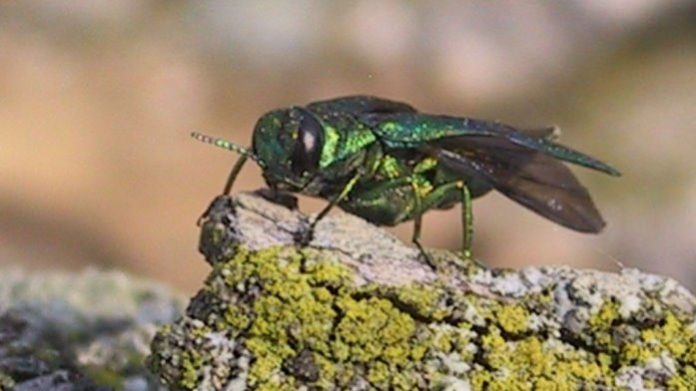Researchers at Natural Resources Canada are breeding a colony of killer parasitic wasps.
No, it’s not the beginning of a terrible made-for-TV movie. It’s a new method for controlling the spread of the emerald ash borer beetle – an insect that has killed millions of ash trees in North America.
An unwelcome guest
If you’ve ever gone camping, you may have heard of the emerald ash borer (EAB) as one of the major reasons you can’t bring your own firewood into provincial or national parks. This invasive species was first introduced to Canada from its native East Asian home in 2002. Since then, it has spread throughout most of Ontario and into Quebec, leaving dead ash trees in its wake.
The EAB beetle lays its eggs specifically on ash trees, allowing the newborn larvae to bore through the bark and feed on the tree’s juicy innards. This eventually causes large cavities to form, killing the host tree.
So far, efforts to get rid of the emerald ash borer have been unsuccessful – because they are a non-native species, they have no natural rivals or predators to control their population. But Krista Ryall, lead researcher on the killer wasp project, hopes that will change soon.
Pest control
This particular wasp species, Tetrastichus planipennisi, is not like any other wasp you’ve ever seen: it is smaller than a fruit fly, doesn’t sting, and is very host specific. That means it will only lay its eggs on EAB larvae and nothing else. The baby wasps then feed on the beetle larvae as they mature.
Since 2013, NRCan has been importing these wasps from a facility in Michigan and letting them loose in various sites across Ontario and Quebec, but with their own breeding program in place, many more sites can be treated.
Unfortunately, because of their specific lifestyle, raising these wasps is not easy. NRCan must maintain a greenhouse full of ash trees to sustain an EAB colony, which, in turn, provides food for the wasps. To reach their goal of treating six more sites in 2017, NRCan must raise at least 12,000 wasps, requiring year-round breeding and maintenance.
It seems a little counter-intuitive to release one non-native species to get rid of another. It reminds me of the Simpsons episode where they release lizards to fix Springfield’s bird problem.
But this time, the wasps’ specific lifestyle becomes a benefit: the wasps shouldn’t cause any trouble for anything but the EAB, and once EAB beetle populations decline, the wasps should also die out.
After release, it will be several years before we’ll be able to tell whether the program worked. But if the killer wasps are able to stop the spread of this devastating pest and successfully protect ash trees, it’ll be worth the wait.








































